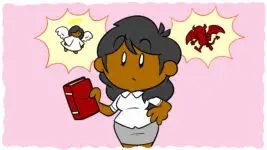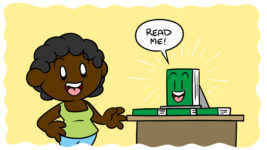Self-publishing authors are experts at spinning plates, splitting their time between writing, editing, publishing, and marketing. Happily, every so often you get the rare plate that almost spins itself, requiring the bare minimum of attention to keep working in your favor. That’s the reading order checklist – a short list of your work that takes fifteen minutes to set up and then only needs to be updated as new projects hit the market.
In this article, I’ll be taking a look at this simple but powerful marketing tool, examining how it works, how you can create your own, and a few tips and tricks to make your reading order checklist as effective as possible.
What is a reading order checklist?
A reading order checklist is an ordered list of everything you’ve written. If you’ve ever tried to tackle a vast series like the Richard Stark Parker books, or dig into the catalog of a prolific author like Stephen King, you’ve probably searched out an unofficial reading order checklist.
The basic purpose of a reading order checklist is to help readers find out about everything you have to offer. If the book they liked is one in a series, they probably already know how to find what’s next, but maybe they want to cast a wider net. A reading order checklist helps them do so while giving you the ability to directly recommend your work.
Creating a reading order checklist also allows you to ensure early works, online content, and completed series aren’t forgotten. If you’re no longer actively marketing a work, that’s fine, but as a working author you’ll always be picking up readers, and they’re likely to want to know about your whole catalog. If you’re in a short-fiction collection or published online, a reading order checklist is a great way to make sure that work continues to find readers. If the work’s free, even better – now you’re rewarding readers for looking into your writing.
Another benefit of a reading order checklist is that it can showcase all your ‘products,’ even in cases where they’re mutually exclusive. For example, this Jasper Fforde reading order checklist mentions both individual books and omnibus collections which include those books. This is an effective way to advertise two products even when a reader is unlikely to want both – something that’s harder with other marketing tools, where you’re rewarded for being specific.
A good reading order checklist can also be attractive to readers with a completionist outlook. It’s a lot more tempting to try and read everything an author has out if there’s a handy list where you can tick off what you’ve read. Prolific authors break their checklists up into sections, and if a reader has read four of the five books under, say, the ‘horror fiction’ heading, it’s inherently tempting to round out the list.
Reading order checklists shouldn’t be pushy – they’re tools for the reader – and they don’t have to be. People come to checklists with different needs, but just by giving them the means to answer their own questions, you can make a sale. Say you’ve just read Fforde’s (excellent) Shades of Grey. If that’s your first experience of his work, you might be looking for something else. Great, but while Fforde’s Thursday Next series is good, it’s also extensive, and it might be all you see when you search for more of his work. In contrast, the reading checklist offers up everything Fforde has on the market, and it also points out his standalone novel Early Riser and the far less intimidating Nursery Crime series. Of course, maybe you want to launch straight into the Thursday Next books – here, again, the reading order has your back, giving you a simple, official order that removes all the anxiety from launching into a seven-novel series.
As an author, it’s almost impossible to create the kind of varied but bespoke marketing that attracts both those readers wanting to begin a series and those looking for standalone content, but a reading order checklist can do exactly that.
What should I include in my reading order checklist?
An official reading order checklist should be professional, simple, and comprehensive. While it’s obviously up to you what you include, I can’t recommend leaving out early or minor work, even if it’s something you now find embarrassing or unrepresentative.
When readers look up a reading order checklist, they’re looking for a comprehensive list, and that’s also what anyone else compiling such a list is trying to create. Start leaving things off and you’re creating a lesser checklist, which could mean readers either go elsewhere (to lists that don’t have the same benefits) or decide they’ll try to figure out what to read next tomorrow (at which point, it’s a coin flip whether you’ll ever see them again.)
Of course, it’s fine to divide your work up into subheadings, so feel free to drop anything you don’t like under an ‘early work’ subheading wayyyyy at the bottom of the page.
So, that’s the first thing to include in your reading order checklist: every piece of writing you can put in front of your reader. But what else do you need?
- Titles – This is obvious, but a list of your work should take the form of a list of titles.
- Covers – Your cover is a sales tool that will also help your reader recognize the book in question on sight, so make sure to include small cover images on your checklist.
- Appropriate headings – While the reader doesn’t need to learn a lot about your books from a reading order checklist, they do need to know the type of book they’re looking at. If you’re a multi-genre author, categorizing by genre is a good decision, and the same is true if the length of your work varies. This fan-made reading list of Stephen King books lists by horror, sci-fi, and crime. Not only does this create a more useful list, but it helps break up a huge body of work.
- Links – One of the best things about a reading list is that you can include links to where your readers can buy your work. This means that a curious reader is only a click away from a purchase. This is one of the key benefits of creating your own list; you get to pick where you’re sending your readers. If you only sell through one online book seller, this is still a feature, but if you sell through more, list them under each book so the reader has a choice. Melissa F. Olson’s reading list links every book straight to its Amazon sales page.
- Reading order information – It can be tempting to include a blurb for each book on your reading list, but resist that urge (for now.) A reading list should be as simple as possible, making it clear what books you’ve written, if and how any of them connect, and whether there’s an intended order in which they should be read. However, if you have any important information that refers to these core ideas, it’s a good idea to include it. One example is Olson’s reading list, which uses asterisks to indicate works which she considers good entry points into her longest series. Likewise, Lucia Ashta’s reading order checklist quickly explains that the protagonist of one series first appears in another. That’s the kind of information readers are looking for in a checklist, so it’s a sensible inclusion.
Where can I use my reading list?
The first place to put your reading list is on your website. This should be home to the simplest, most stripped-down version of your list. Other pages of the site might expand on what the books are about (and the online store pages you’re linking to should include full book blurbs,) so the most important thing here is to suggest a clear order the reader can trust. If you’ve written mostly standalone work, just go for chronological order, setting any series aside under their own headings as needed.
The next place to include your reading list is in every book you publish. It’s not vitally important to update your old books every time you publish something new, but try to keep up to this early on in your career so you don’t give budding fans the impression that there’s nothing else to read.
If you’re listing a series, don’t skip the book in which the list appears (that is, The Crossguard Series: Book 2 should appear in the reading order published in The Crossguard Series: Book 2.) A lot of authors don’t bother, seeing as the reader has clearly already found that book, but this just means that the reader has no ready indication of where the book they’re reading comes in the reading order. Sometimes, it’s obvious, but sometimes it’s not: if Harry Potter and the Chamber of Secrets doesn’t include itself in its own reading order checklist, the reader has no way of knowing it’s the second in the series without consulting an outside source. It’s potential harm without any possible benefit.
A final option for your reading order is to publish it as its own document. This was the path taken by author Rachel Amphlett, who created her own free-to-download reading order after finding out that someone else was charging readers for their own unofficial version. This kind of reading order checklist can be a little more extensive, including book blurbs or even sample chapters. The more you offer the reader for free, the more value you’re attaching to what’s ultimately a great marketing tool. This kind of pseudo-catalog of your own work can also be useful if you decide to try and attract publishers or sell your books to libraries. Putting together an attractive catalog is an investment of time, but ultimately you’re only ordering and presenting resources you already possess.
A final thing to consider is including the work of other authors in your checklist. Obviously, you should be clear that it’s not your work, and it should be the last thing you list, but if there’s a list of books that inspired you, or that you feel your readers would also enjoy, you’re only adding value by offering them up (as well as creating opportunities for some indie-author quid pro quo.)
The self-spinning plate
A reading order checklist is a useful tool that many readers really appreciate, and making life easier for people who want to buy your work is always going to be to your advantage. Checklists don’t have to be huge to help you out – a simple list of your work is a basic tool your reader will appreciate however long it is – but they’re vital if you’re producing a lot of work or working in multiple genres. Just remember to keep it simple and, every so often, update your lists to keep them accurate. You can even list upcoming projects so readers know to look out for something in the future (just be sure they’re projects you’ll definitely complete.)
Do you have any questions about creating your own reading order checklist, or do you have a favorite book you only found because of a particularly comprehensive list? Let me know in the comments, and check out The 6 Essential Features Of A Fiction Writer’s Website (And 1 Bonus You Should Try) and How To Get Libraries To Buy Your Book for more advice relevant to this subject.





